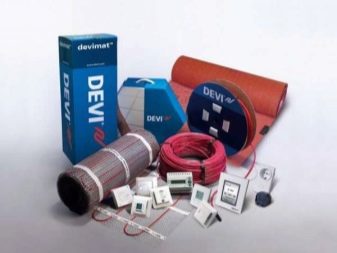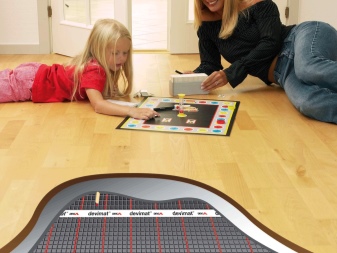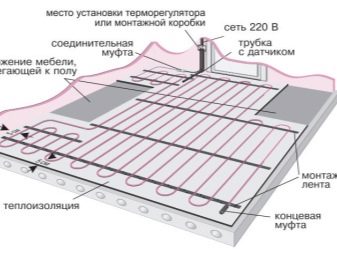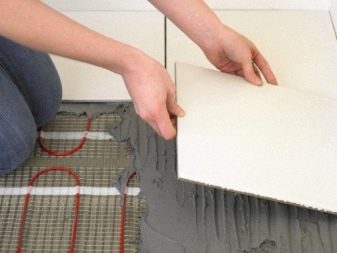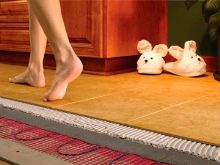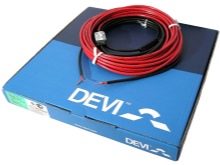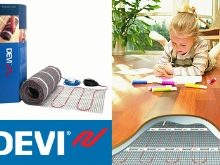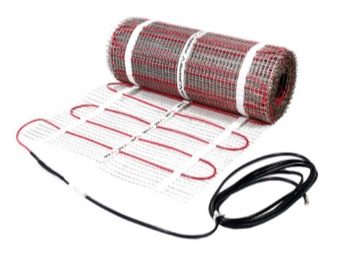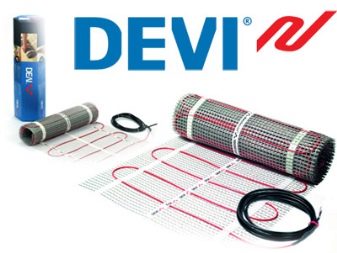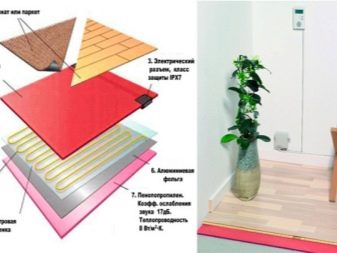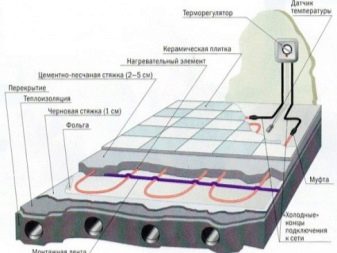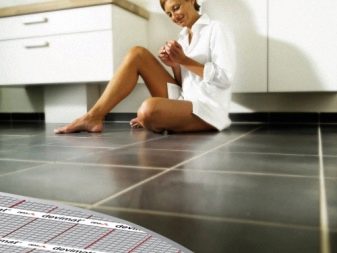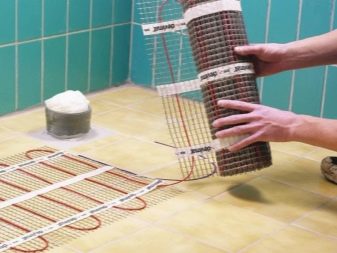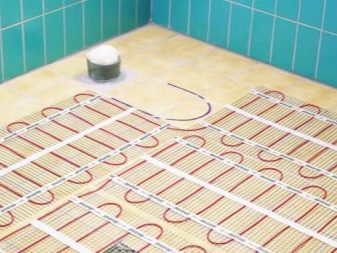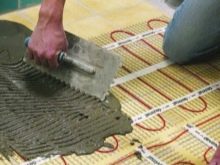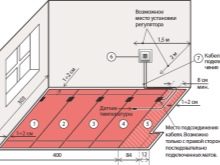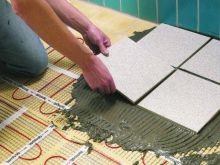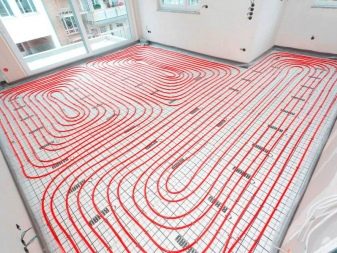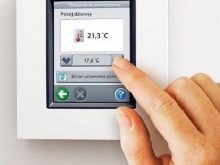Devi warm floor: advantages and disadvantages
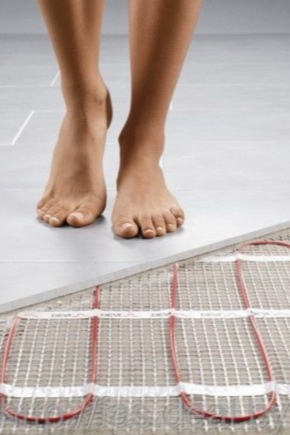
When building a private house, many are faced with the task of heating. Everyone wants to heat not only the walls, but also the floor. The solution to this problem is heated floors, which create such a comfortable and pleasant feeling of passing through it. The advantage of the system is that there are no fluctuations of warm and cold air, as from other types of heating, and the absence of drafts.
Features and specifications
Very popular in the interior is a warm floor from the firm known manufacturers Devi. Materials produced by this brand, manufactured to high standards and qualities. Anyone who decides to install floor heating is facing this brand.
Devi heat-insulated floor differs from other manufacturers in that it produces not only heating cables, but also special equipment - regulators, connection elements, thermostats with an LCD display. Created cooperation between heating systems. As a result, this brand is recognized as the most safe and environmentally friendly device: it has received the certificate of ISO 14001 class.
The main advantages of Devi warm floor:
- Heating at home occurs in a fairly short period of time. Due to the installed Devireg thermostat, you can set a certain constant temperature without the risk of drops. You can control the system using a PC. In each room it is possible to set a different temperature.
- Flows of energy are transmitted to the surrounding air. They rise up, and the heat passes through the legs. Due to the fact that the energy does not rise to the ceiling, it is not wasted, as with conventional heating of the apartment. Therefore, heat dissipates evenly throughout the room.
- Operates independently of the main central heating.
- Does not emit extraneous odors and harmful fumes.
- Manufacturer's warranty warm floor 10-20 years, but the actual time is much longer.
- It is installed under any floor covering and in a specific area that needs to be heated.
- Does not occupy space in the apartment, thus the interior of the house does not change.
- Suitable for families with small children. Thanks to its automated system, if a human body touches the cable, the system automatically shuts down.
Like many other types of warm floor, Devi product has its drawbacks:
- High cost of production.
- In chronic diseases of the feet the use of this heating is prohibited.
- Special attention requires the operation of the electric floor. If the structure breaks down, it will be difficult to find out where the failure occurred.
- Near the walls, heat transfer is much greater than in the middle of the floor. Therefore, it is necessary to install an electric floor so that the heat transfer is distributed evenly.
- Electricity can damage rooms that have high humidity.
Models
There are two types of warm floors: it is a cable and heating mat. The electric cable is much cheaper than the cost of the mat, you can configure in which area of the floor the heating line will go.The heating mat is a synthetic mesh with attached cables.
Due to a certain interval between cables, the effect in heating will be the highest. The use of a heating mat does not require an initial screed. After its installation, you can proceed to the floor covering.
Also distinguish:
- strong;
- single core cables.
The models have a special reputation:
- Deviflex-Strong insulated electrical cables that are fastened in a tie. They are installed in concrete to a depth of 7 cm. They are easy to use in that they are completely invisible, thus mechanical damage is not terrible.
- Devimat - double or double cables attached to a synthetic material (heating mats). They are installed directly under the floor covering (under the tile, under the tile) with mounting glue.
- DeviIdry Thermal Systemdesigned for flooring made of wood (boards, parquet, laminate). Due to the existing Devireg thermostat and insulation, electrical safety contact with the wooden surface is ensured. This is a do-it-yourself kit. Does not require special skills. The basis for this is not necessary.
- Devireg-thermostat.
It is most in demand due to its advantages:
- control of the system using smartphones and a computer via Wi-Fi network;
- simple menu for manual system setup;
- system setup depending on the type of room and flooring;
- Restoring settings occurs when entering the code.
Design
The basis of the Devi system is the electrical resistance of metals. Electricity heats the metal, which transfers heat to the air.
The design of the electric floor heating Devi is as follows:
- priming;
- foundation of the floor;
- heat insulation;
- waterproofing;
- mounting tape;
- heating cable;
- screed.
Thermal sensor must be installed when using heating mats.
Principle of operation
When connected, the electrical cable transfers thermal energy to the floor covering, which is a heat exchanger. From this, the air is heated.
The process of heating the floor looks like this:
- Devi temperature controller receives data from the temperature sensor on the current temperature.
- A current of a certain magnitude is supplied from the set temperature to heat the flooring.
- When the desired air temperature is reached, the power turns off automatically.
When the temperature drops, the whole process resumes again. The most popular model of thermostat Devilink. It has the ability to control the entire surface heating system (temperature sensors, boiler, radiator). The amount of electricity consumed depending on the set temperature.
The warming up time of the floor covering is short: it occurs within 10 minutes. The temperature of the surface heating depends on the correctness of the installation work.
In order to properly connect the underfloor heating system, you need to read the operating instructions.
Mounting technology
Installation of cable heating requires sequential actions:
- Preparation of the base of the floor, which should be perfectly smooth. For this purpose the foundation for the floor is used. It is initially leveled using screed and mortars (plaster or cement).
- Thermal insulation is needed to reduce heat output. It is especially recommended for cold floors (balcony, basement, garage).Expanded polystyrene, cork agglomerate, styrodur perfectly suited for this role. Insulation made without extra airbags. This is what can cause the breakdown of a single cable or the entire system.
- In the rooms, where the contact of the floor with water (bath, sauna, bathroom), waterproofing is required. For this purpose, suitable conventional plastic film.
- Thermal insulation and waterproofing is filled with a mixture of water, sand and cement (in the ratio 3: 2: 1).
- To ensure that heat is evenly distributed over the flooring, the screed is covered with a special foil or metal mesh. It is also used to prevent overheating of the cable, uneven temperature distribution.
- Before installing the cable is laid mounting tape. Thanks to the existing brackets, it securely fastens the cable.
- Attaching heating elements to the mounting tape. The temperature sensor measures the temperature, and the thermostat controls the surface heating temperature. Cables should be laid in such a way that there is a distance of at least 50 mm between them.
- The laid structure is poured with a cement mixture. A minimum fill thickness of 0.5 cm-5 cm is recommended.
- After the cement screed has completely dried, you can proceed to the flooring (tile, laminate, ceramic tile).
Installation of heating mats is notable for its simplicity and convenience:
- suitable for any floor covering;
- can be reduced by cutting with scissors;
- self-adhesive glue is available that securely fixes.
Lay the heating mats on the primed surface of the foundation, which is pre-cleaned of contamination. Also, there should be no irregularities and cracks.
Due to self-adhesive glue mats are not shifted. A corrugated pipe is laid between the cable grooves. The other end is led to the wall to connect the heating cable and the temperature sensor to the temperature controller.
The flooring is attached to the glue base. The thickness of the glue should be no more than 1 cm. After that it will be possible to connect the heating mats to the thermostat. Such a system is used for laminate, parquet, carpet.
To avoid problems, you need to pay attention to the following recommendations:
- Connect the heating sensor to the general network only after the complete drying of the screed (after 5 days).
- The thermostat sensor does not fill with a coupler.Its installation is carried out in a corrugated pipe and at a distance of 30 cm from the floor. Upon failure, it can be repaired without much effort.
- When buying a kit for a specific floor covering, be sure to consider the power of the heating element. Some flooring materials can conduct heat poorly or the coating will become unusable. In the bathroom, the power cables should be 120W / square meter. In residential premises 100W / square meter.
- Be sure to measure out the necessary cable length, because cutting it is strictly prohibited. Therefore, to reduce will not work.
- It is necessary to check the resistance data when connecting the electrical cable.
- Before laying the cable, it is necessary to draw a diagram considering the distance to the walls. The calculation of the necessary material depends on the area of the room, the heated zone and heavy furniture with legs. There are types of cables that are not designed for gravity.
- It is possible to calculate the laying step using the formula: h (laying step, cm) = (S area, m * 100) / (L cable length, m).
- The manufacturer recommends the use of quick-drying mixtures that dry during the day.Before pouring it, it is imperative to make a groove in the wall to reach the network of the temperature sensor.
- Thermal insulation is necessary not only for the floor, the ceiling and walls must be insulated, otherwise the heat will go outside.
Setting up and installing a floor heating system is easy. Properly executed instructions enable long-term service.
Customer Reviews
Underfloor heating has recently become extremely popular, which is why a lot of reviews about Devi brand products have appeared.
People share options for using this system. For example, it is interesting that, thanks to the warm electric floor, the soldiers standing in the guard near the walls of the Kremlin, maintained a fixed state for a long time. Indeed, in the glass structures of the foundation are installed heating cables brand Devi.
Many people install a warm electric floor in the apartment, as they have small children who are constantly on the floor. There are cases where people have previously often been in hospitals with babies. Since the Devi warm floor was installed, the situation has changed for the better.
Some have installed this heating for parents in the village. Now much less money goes to the main heating.Celebrate simple and clear installation with their own hands without any problems. The main thing is to follow the installation technique during installation.
Also, some users advise the manufacturer of the brand Devi to those associated with the automotive business. Previously, in cold weather, it was impossible to be on the concrete floor, the user notes, he constantly got cold, and the repair ended in a hospital. After installing a warm floor in the garage, you can not worry about your health and I can poke around with the car for days on a warm floor.
How to mount a Devi warm floor, see the next video.

